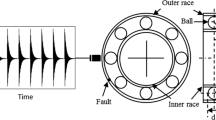Abstract
The Mathematical morphological filter (MMF) is widely applied in vibration signal processing for fault diagnosis. The Structure element (SE) and the cutoff frequency of filter have important impacts on the filtering effect, but there is no selection principle of these parameters for vibration signal processing in fault diagnosis. In this paper, the working mechanism of the MMF is studied, and a novel technique with filter characteristics and selection criterion of the MMF is proposed. The filter characteristics of morphological filter are described through frequency response analysis. The relationship between the SE length and the cutoff frequency of MMF is put forward, and the quantitative selection method of SE in engineering is proposed to effectively remove the noise and detect the impulses. The method is evaluated using both simulated signal and experimental bearing vibration signal. The results show that quantized selection method can make MMF have the better filtering effect, and can reliably extract impulsive features for bearing defect diagnosis. The study provides a theoretical basis for the application of MMF in vibration signal processing.
Similar content being viewed by others
References
K. Elbhbah and J. K. Sinha, Vibration-based condition monitoring of rotating machines using a machine composite spectrum, Journal of Sound and Vibration, 332 (11) (2013) 2831–2845.
K. Dimitrios, M. Dimitrios and P. Xanthoula-Eirini, A machine learning approach for the condition monitoring of rotating machinery, Journal of Mechanical Science and Technology, 28 (1) (2014) 61–71.
F. Y. Cong, J. Chen and G. G. Dong, Spectral kurtosis based on AR model for fault diagnosis and condition monitoring of rolling bearing, Journal of Mechanical Science and Technology, 26 (2) (2012) 301–306.
P. Maragos and R. W. Schafer, Morphological fi1ters -Part I: Their set theoretic analysis and relation to linear shift invariant filters, IEEE Trans. on ASSP, 35 (8) (1987) 1153–1169.
P. Maragos and R. W. Schafer, Morphological fi1ters-Part II: Their relation to median,order-statistic,and stack filters, IEEE Trans on ASSP, 35 (8) (1987) 1170–1184.
N. G. Nikolaou and I. A. Antoniadis, Application of morphological operators as envelope extractors for impulsivetype periodic signals, Mechanical Systems and Signal Processing, 17 (6) (2003) 1147–1162.
C. Li and M. Liang, Continuous-scale mathematical morphology-based optimal scale band demodulation of impulsive feature for bearing defect diagnosis, Journal of Sound and Vibration, 331 (26) (2012) 5864–5879.
B. Samanta and C. Nataraj, Morphological signal processing and computational intelligence for engineering system prognostics, Journal of Systems and Control Engineering, 223 (8) (2009) 1095–1109.
S. Gautam and S. M. Brahma, Overview of mathematical morphology in power systems -A tutorial approach, IEEE on PES General Meeting, 7 (2009) 1–7.
C. Shen, Q. He and F. Kong, A fast and adaptive varyingscale morphological analysis method for rolling element bearing fault diagnosis, Journal of Mechanical Engineering Science, 227 (6) (2013) 1362–1370.
A. S. Raj and N. M. Early, Classification of bearing faults using morphological operators and fuzzy inference, IEEE Transactions on Industrial Electronics, 60 (2) (2013) 567–574.
Y. B. Dong, M. F. Liao and X. L. Zhang, Faults diagnosis of rolling element bearings based on modified morphological method, Mechanical Systems and Signal Processing, 25 (4) (2011) 1276–1286.
Z. Zhao, L. L. Liu and C. X. Zang, Research and analysis of morphological filter’s structure element selection principle, Power System Protection and Control, 37 (14) (2009) 21–35.
B. Li, P. Zhang and Z. Wang, Gear fault detection using multi-scale morphological filters, Measurement, 44 (10) (2011) 2078–2089.
W. He, Z. N. Jiang and Q. Qin, A joint adaptive wavelet filter and morphological signal processing method for weak mechanical impulse extraction, Journal of Mechanical Science and Technology, 24 (8) (2010) 1709–1716.
S. J. Dong, B. P. Tang and Y. Zhang, A repeated singlechannel mechanical signal blind separation method based on morphological filtering and singular value decomposition, Measurement, 45 (8) (2012) 2052–2063.
D. Wang, P. W. Tse and Y. Tse, A morphogram with the optimal selection of parameters used in morphological analysis for enhancing the ability in bearing fault diagnosis, Measurement Science Technology, 23 (2013) 065001.
F. F. Costa, A. J. S. Filho and C. E. Capovilla, Morphological filter applied in a wireless deadbeat control scheme within the context of smart grids, Electric Power Systems Research, 107 (2014) 175–182.
Bearing Data Center, Case Western Reserve Univ., Cleveland, OH. [Online], http://www.eecs.case.edu/laboratory/ bearing.
L. J. Zhang, J. W. Xu and J. H. Yang, Multiscale morphology analysis and its application to fault diagnosis, Mechanical Systems and Signal Processing, 22 (3) (2008) 597–610.
S. Abbasion, A. Rafsanjani and A. Farshidianfar, Rolling element bearings multi-fault classification based on the wavelet denoising and support vector machine, Mechanical Systems and Signal Processing, 21 (7) (2007) 2933–2945.
Author information
Authors and Affiliations
Corresponding author
Additional information
Aijun Hu received the M.S. and the Ph.D. degrees from the North China Electric Power University, Baoding, Hebei Province, China, in 1998 and 2006, respectively. He is an Associate Professor with the Department of Mechanical Engineering, North China Electric Power University, China. His current research interests are fault diagnosis, vibration measurement and signal processing.
Ling Xiang received the B.Sc. and M.Sc. degrees in mechanical engineering system, from the North China Electric Power University, Baoding City, China, in 1993 and 1998, respectively. She received the Ph.D. degree in electrical power engineering system, from the North China Electric Power University, Baoding City, China, in 2009. Currently, she is a Professor in the Department of Mechanical Engineering. Her main research interests include the condition monitoring and fault diagnosis.
Rights and permissions
About this article
Cite this article
Hu, A., Xiang, L. An optimal selection method for morphological filter’s parameters and its application in bearing fault diagnosis. J Mech Sci Technol 30, 1055–1063 (2016). https://doi.org/10.1007/s12206-016-0208-4
Received:
Revised:
Accepted:
Published:
Issue Date:
DOI: https://doi.org/10.1007/s12206-016-0208-4




